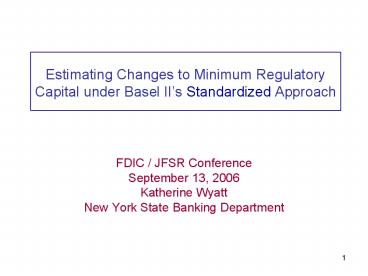Estimating Changes to Minimum Regulatory Capital under Base - PowerPoint PPT Presentation
1 / 14
Title: Estimating Changes to Minimum Regulatory Capital under Base
1
Estimating Changes to Minimum Regulatory Capital
under Basel IIs Standardized Approach
- FDIC / JFSR Conference
- September 13, 2006
- Katherine Wyatt
- New York State Banking Department
2
Outline
- Survey of New York banks 2001 2002
- Update preliminary results
- Comparison with Quantitative Impact Studies
conducted by Basel Committee and in Germany
(2004) - Potential Issues in implementing Standardized
Approach
3
(No Transcript)
4
Standardized Approach Study at 27 New York Banks
- Banking Department used Call Reports as of
6/30/01 and 12/31/01 - Banks in study ranged in asset size from over
100 million to under 40 billion, and included
both commercial and savings banks. - Banks represented different business plans, with
variation in portfolio composition - Items on the RC-R that could receive different
risk-weighting under the Standardized Approach
were identified, and banks were consulted to
determine the new risk weight - For example, banks were asked about exposures to
rated counterparties, which claims were backed by
guarantees or collateral, and about maturity of
unused commitments and whether unused
commitments were unconditionally cancelable by
the bank
5
Average Changes in Required Capital, 27 NY Banks,
12/31/01
6
Weighted Average Op Risk Contribution to Change
in Required Capital 12.3 increase, but
variation for individual banks.
Banks ranked by asset size, in decreasing order.
7
International Survey Results for Standardized
Approach
8
Average Contributions to Change in Required
Capital
9
New York Survey Update 6/30/06
- 2001 survey population has changed mainly due to
consolidation updated survey covers 17 of the
original 27 New York banks - Requested information from banks based on June 30
Call Report not all information in yet - Too early to report on effect of recognition of
external ratings, treatment of unused
commitments, or credit risk mitigation - However, we can make preliminary estimates of
changes in risk-weighting for retail portfolio,
loans past due 90 days or more, and the
operational risk charge - Basic Indicator op risk charge calculated as
average of 12/31/03, 12/31/04, and 12/31/05 gross
income minus insurance income
10
Preliminary Estimated Change in Risk Weighted
Assets for Retail Portfolio, Loans Past Due 90
Days, and Operational Risk
Weighted average change in items for 17 banks
assumption that immaterial amount of small
business and other retail loans backed by
eligible collateral or guarantees.
11
(No Transcript)
12
Changes in Required Capital for Off-Balance Sheet
Items
- Under Standardized Approach unused commitments
that are not unconditionally cancelable by the
bank will receive a credit conversion factor
(CCF) 20 CCF for those under one year in
maturity, and 50 CCF for those over one year in
maturity. - Exposure after credit conversion for letters of
credit, commitments, or derivatives will be risk
weighted according to public rating. The 50
limit on the risk weight for derivative exposures
is lifted. - The survey banks in 2001 had few derivatives
exposures, and few rated counterparties for
letters of credit or commitments. - Required capital for unused commitments under one
year contributed almost 3 to change in capital
requirements in 2001
13
Potential Issues
- Treatment of home equity loans
- Treatment of credit risk mitigation under the
Simple Approach - Varying capital requirements for operational risk
if based on banks gross income - Limited risk sensitivity
- Competitive balance with Advanced Approach banks
14
Conclusion
- Research suggests that it is likely that
adoption of Standardized Approach would not lead
to large drops in required capital - Estimates of changes in capital from Standardized
Approach can be obtained from analysis of Call
Report submissions and minimal consultation with
banks - Issues remain that could require U.S. adaptations
if Standardized Approach adopted































